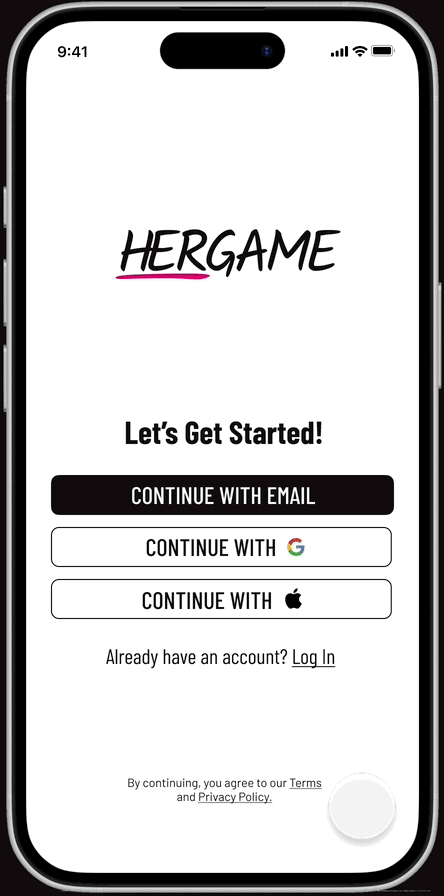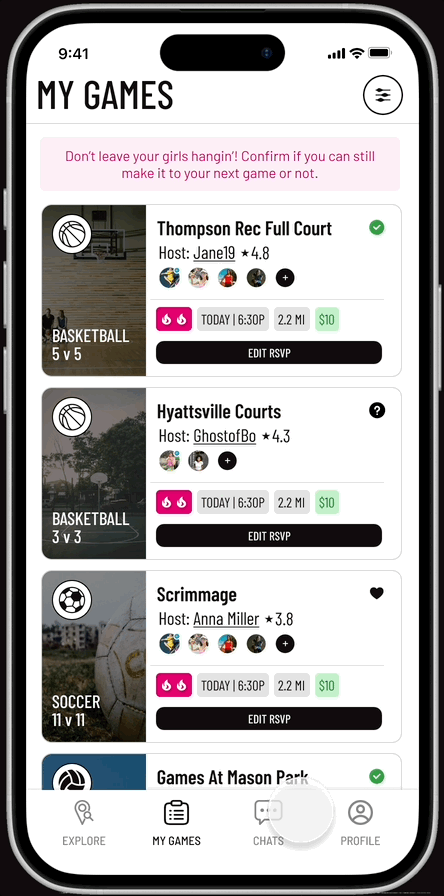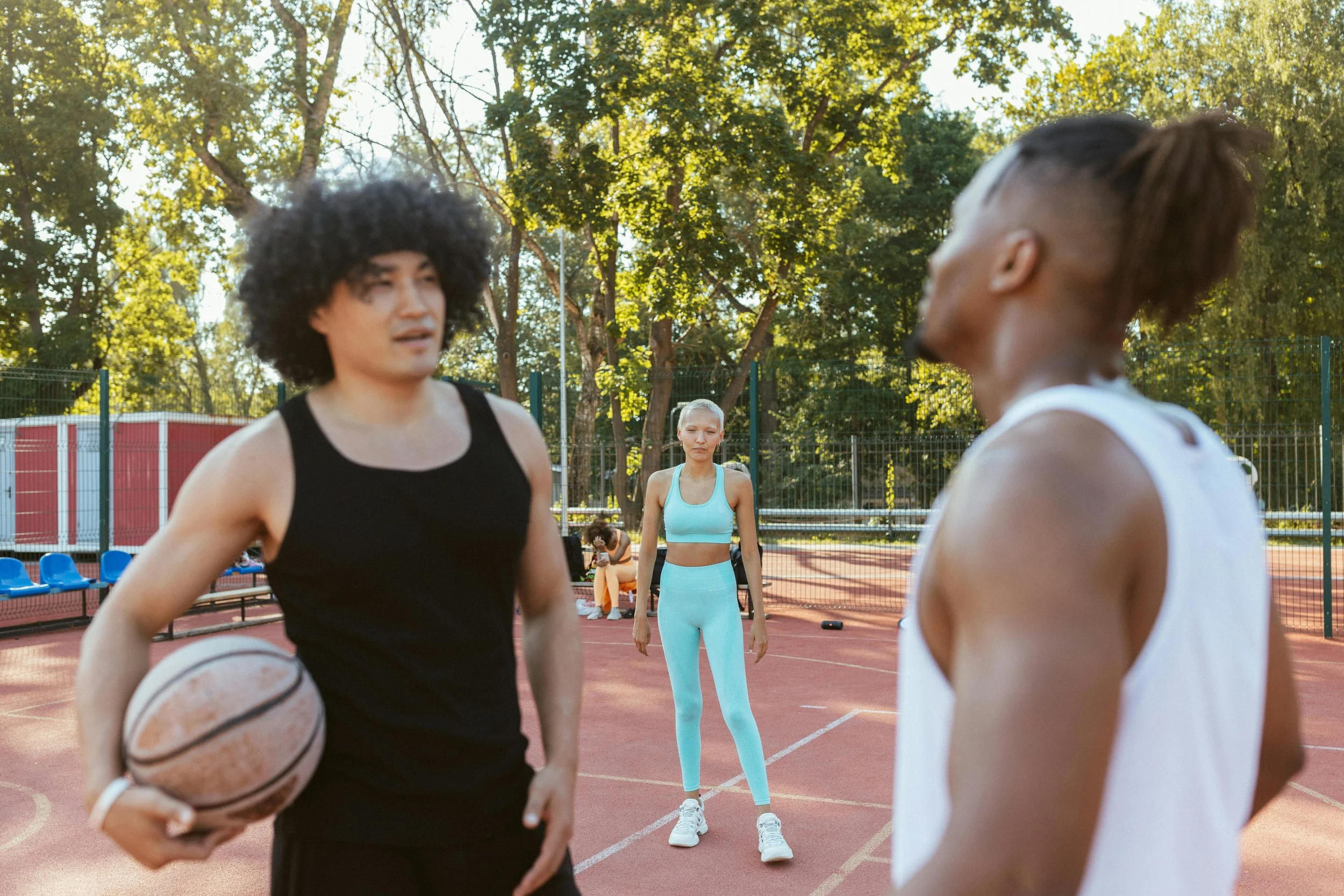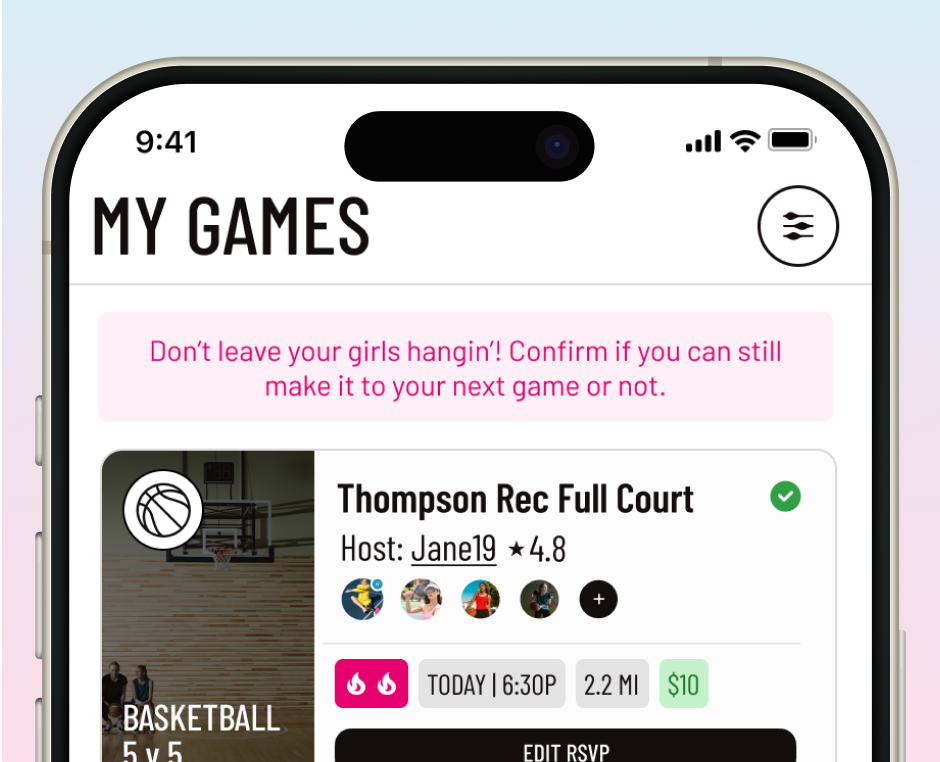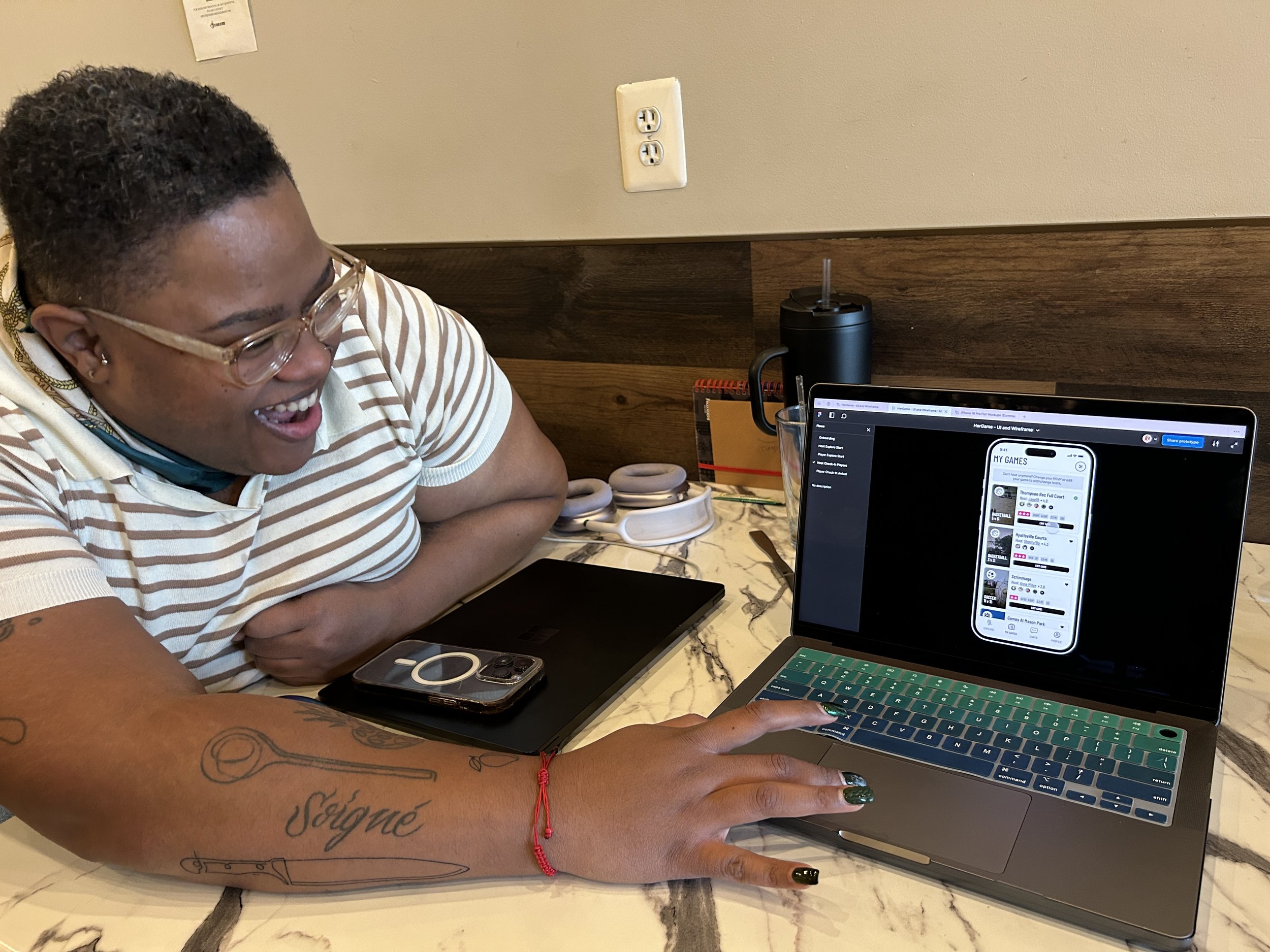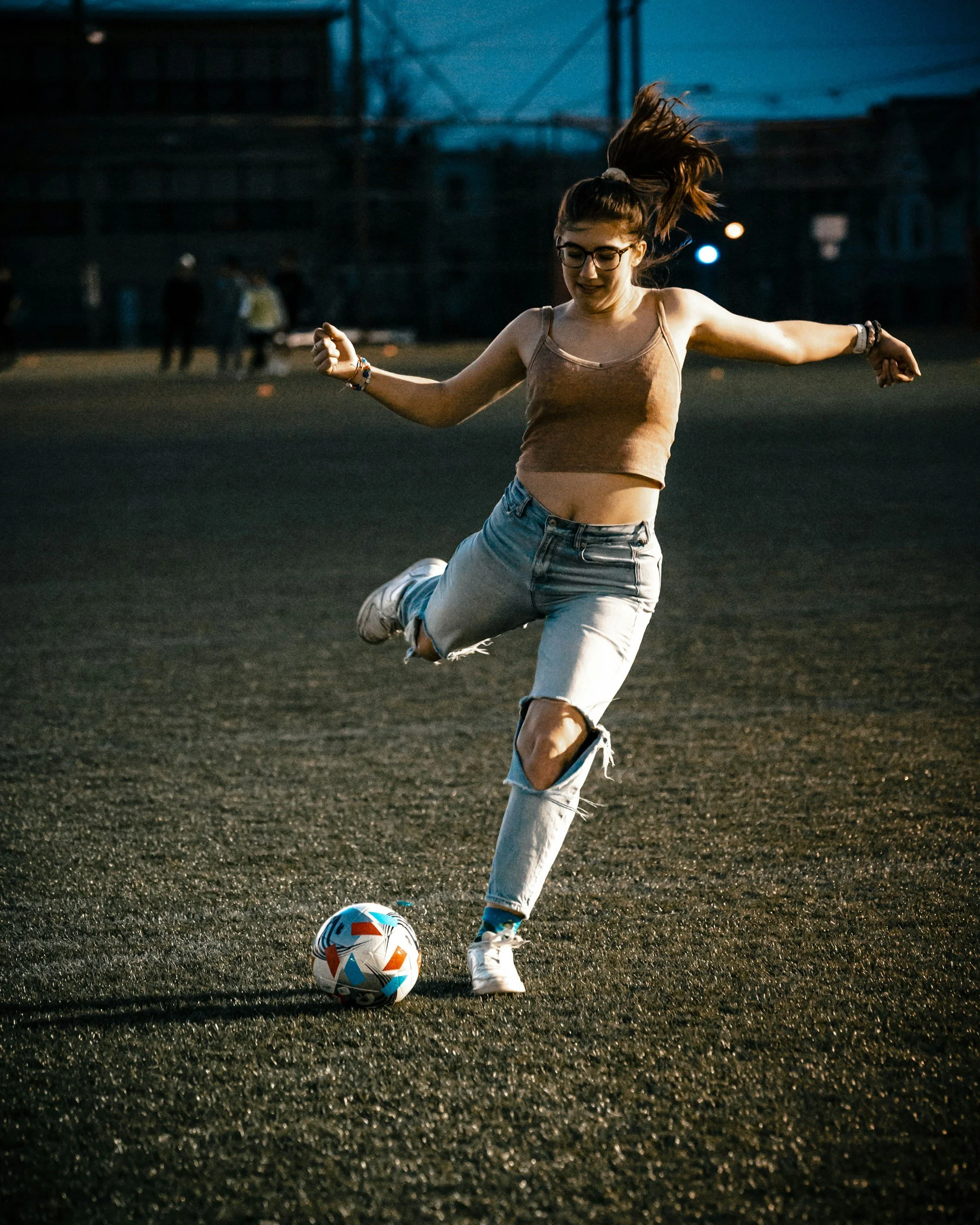Consumer-Facing • B2C • 0-1 Design
Reducing Barriers to Women’s Participation in Pick-up Sports
As the founding product designer, I led the six-month pre-MVP design of HerGame, a mobile app that helps women confidently find, host, and join local pickup games. Through user research, UX/UI design, and usability testing, I created a high-fidelity prototype that achieved 91% task success and revealed strong market potential within the $30B recreational sports industry for tools centered around the needs of women athletes.
Role:
Founding Product Designer
Timeline:
6 months
Scope:
Research • UX/UI Design • Prototyping • Usability Testing
36% increase in usability
100% task completion.
Results at a Glance
Positive user sentiment (“Made for women like me”)
Validated market opportunity
Problem
Women Want to Play, but There is Limited Access to Welcoming and Reliable Casual Games
Team sports participation among girls aged 13–17 grew from 54% to 58% between 2020 and 2023, but many women still struggle to find inclusive, reliable ways to play as adults.
In my own research, 86% of surveyed women said it was difficult to find and join games consistently, citing unclear skill levels, no-show players, and discomfort in co-ed spaces. The issue isn’t motivation; it’s that most existing tools aren’t built for women’s real needs around safety, trust, and community.
This disconnect points to an opportunity to design experiences that bridge those gaps and turn interest into participation— helping more women feel confident showing up to play.

Opportunity
How might we help women feel confident showing up to play pick-up sports by designing systems that foster safety, trust, and connection?
This question became the foundation of HerGame’s design and shaped every decision, from onboarding and game discovery to visual tone and community-building features.
Goals
Design a Product Experience That Makes Casual Sports More Accessible and Enjoyable for Women.
HerGame focuses on reducing friction and uncertainty by making it easier to find trustworthy players, consistent schedules, and safe spaces. I didn’t only want to simplify the logistics of the game-finding process; I also wanted to foster a stronger sense of belonging and confidence around recreational play.
From a business standpoint, the design process explored how a women-centered sports platform could scale through community engagement, modest venue fees set by hosts, and possible in-app merch offers — validating both the user need and market potential.
Solution
DESIGN PRIORITY 1
• Familiar and secure onboarding that helps users get started quickly.
HerGame Introduces a Tested System for Women to Confidently Find, Host, and Join Local Pick-up Games
The app blends familiar UX patterns with community-driven features designed to make participation safe, reliable, and enjoyable.
A few top design priorities, such as secure onboarding, lightweight RSVP controls, and informative game cards, guided the experience. Together, these elements create a product that builds trust through clarity and consistency.
DESIGN PRIORITY 2
• Minimal RSVP process to reduce no-shows and encourage accountability.
DESIGN PRIORITY 3
• Game cards with clear social cues and info tags like:
1. Who’s playing
2. Intensity level
3. Logistic details

Research & Design
Understanding the Problem
Learning About the Challenges Women Face on the Field and the Court
Before conducting interviews, I reviewed existing studies on women’s sports participation, which consistently cited lack of safety, inclusion, and access as key factors driving the drop-off after adolescence.
To explore these dynamics firsthand, I surveyed and interviewed women ages 26–45, ranging from beginners to former athletes, to uncover both logistical and emotional barriers to play.
“In co-ed games, if you’re not as skilled, it’s because you’re ‘just a girl’, but if you’re good or better, then the tone sometimes shifts to something more aggressive and unfriendly. The unpredictability is exhausting.”
- Acrivi C., Interviewee & Tester
Key Research Findings
86% said it was difficult to find and join games consistently.
57% said connecting with other women to play was difficult or very difficult.
Privacy, safety, and reliability were top concerns.
Even experienced players described feeling anxious about the range of skill levels, the intensity of competitiveness, and non-communicative no-show players.
These findings informed everything from core features to the app’s tone of voice
My Design Process
Translating Insights Into Trust-Building Design
I focused on translating the most crucial emotional needs into practical systems. This meant creating flows that encouraged trust without demanding too much from new users. Every screen — from onboarding to RSVP management — was designed to feel clear, fun, and supportive.
Concerns about Reliability
Participants expressed that while it’s good to be able to find others to play with, it’s also important that those players show-up to play or communicate about a change in plans. Streamlined flows offered simple actions for quick updates and notifications between players and hosts on game day.
Designed with Playfulness in Mind
The interface used clean layouts, generous white space, and friendly microcopy to create an experience that feels fun, modern, and approachable—even for users new to sports or event apps.
Light-hearted competition level descriptions
Persistent, but fun, reminder to communicate
Systems for Informed Connections
Women can find the kind of games they’re looking for and make the kind of games they want to play with iconic visual indicators that are explained through optional in-app tooltips—important parts of an overall evolving design system

Results & Learning
User Feedback & Usability Testing
Two rounds of usability testing — held remotely and on-site — revealed strong enthusiasm for the concept and positive reactions to the experience.
“I wish something like this had existed when I was younger.”
- Ash, Tester, Former D1 Athlete
Testing session held at a cafe with Dani H.
What users showed me:
The app felt inviting, modern, and easy to trust
Casual players felt comfortable using it and could see themselves playing more often
Several said they felt like they were finally the intended user of a sports app
86% navigated key flows (onboarding, RSVP, host controls) without guidance
Usability testing also surfaced specific improvements, which led to:
More intuitive RSVP controls
Clearer game visibility and player details
Improved onboarding tips to build confidence from the start
What I Learned
Designing HerGame reinforced several important principles that I’ll carry forward into future work:
Design for someone, not everyone.
Staying focused on a clear primary user helped me make better, more intentional design decisions.
Validate early and often.
Assumptions I had about flow clarity and user priorities were challenged through testing — and the product got stronger every time I listened.
Small touches matter.
Microcopy, tone, spacing, and visual contrast all contributed to how confident and comfortable users felt navigating the app.
Next Steps
Building out messaging and invite flows to strengthen community connection
Refining the venue participation strategy for local partnerships and game hosting
MVP development and closed beta testing
The long-term vision is to support a wide range of play styles — whether someone wants to shoot around with a few friends or organize a full scrimmage. At its core, HerGame is about making it easier for more women to play, more often.

